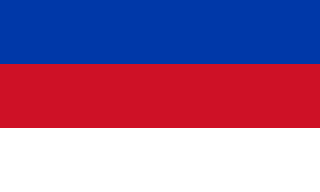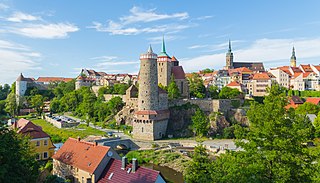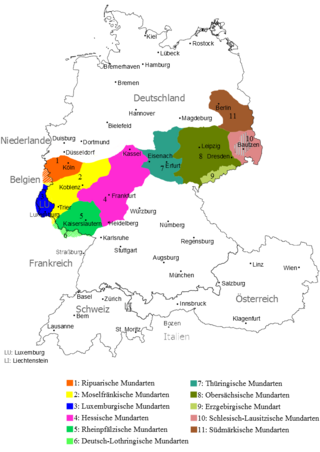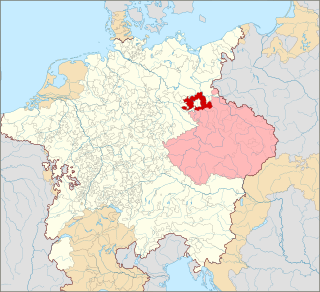
The Sorbian languages are the Upper Sorbian language and Lower Sorbian language, two closely related and partially mutually intelligible languages spoken by the Sorbs, a West Slavic ethno-cultural minority in the Lusatia region of Eastern Germany. They are classified under the West Slavic branch of the Indo-European languages and are therefore closely related to the other two West Slavic subgroups: Lechitic and Czech–Slovak. Historically, the languages have also been known as Wendish or Lusatian. Their collective ISO 639-2 code is wen.

Saxony, officially the Free State of Saxony, is a landlocked state of Germany, bordering the states of Brandenburg, Saxony-Anhalt, Thuringia, Bavaria, as well as the countries of Poland and the Czech Republic. Its capital is Dresden, and its largest city is Leipzig. Saxony is the tenth largest of Germany's sixteen states, with an area of 18,413 square kilometres (7,109 sq mi), and the sixth most populous, with more than 4 million inhabitants.

Cottbus or Chóśebuz is a university city and the second-largest city in the German state of Brandenburg after the state capital of Potsdam. With around 98,000 inhabitants, it is the most populous city in Lusatia. Cottbus lies in the Sorbian settlement area of Lower Lusatia, and is the second-largest city on the River Spree after Berlin, from which it is situated around 125 km (78 mi) upstream. The city is located on the shores of Cottbus Eastern Lake, which will be Germany's largest artificial lake by surface area when flooding is completed.

Sorbs are an indigenous West Slavic ethnic group predominantly inhabiting the parts of Lusatia located in the German states of Saxony and Brandenburg. Sorbs traditionally speak the Sorbian languages, which are closely related to Czech, Polish, Kashubian, Silesian, and Slovak. Upper Sorbian and Lower Sorbian are officially recognized minority languages in Germany.

The Spree is, with a length of approximately 400 kilometres (250 mi), the main tributary of the River Havel. The Spree is much longer than the Havel, which it flows into at Berlin-Spandau; the Havel then flows into the Elbe at Havelberg. The river rises in the Lusatian Highlands, that are part of the Sudetes, in the Lusatian part of Saxony, where it has three sources: the historical one called Spreeborn in the village of Spreedorf, the water-richest one in Neugersdorf, and the highest elevated one in Eibau. The Spree then flows northwards through Upper and Lower Lusatia, where it crosses the border between Saxony and Brandenburg. After passing through Cottbus, it forms the Spree Forest, a large inland delta and biosphere reserve. It then flows through Lake Schwielochsee before entering Berlin, as Müggelspree.

Lusatia is a historical region in Central Europe, split between Germany and Poland. Lusatia stretches from the Bóbr and Kwisa rivers in the east to the Pulsnitz and Black Elster rivers in the west, and is located within the German states of Saxony and Brandenburg as well as in the Polish voivodeships of Lower Silesia and Lubusz. Lusatia's central rivers are the Spree and the Lusatian Neisse, which constitutes the border between Germany and Poland since 1945. The Lusatian Mountains, separate Lusatia from Bohemia in the south. Lusatia is traditionally divided into Upper Lusatia and Lower Lusatia.
Upper Sorbian, occasionally referred to as "Wendish", is a minority language spoken by Sorbs in Germany in the historical province of Upper Lusatia, which is today part of Saxony. It is grouped in the West Slavic language branch, together with Lower Sorbian, Czech, Polish, Slovak and Kashubian.
Lower Sorbian is a West Slavic minority language spoken in eastern Germany in the historical province of Lower Lusatia, today part of Brandenburg.

Bautzen or Budyšin, until 1868 Budissin, is a town in eastern Saxony, Germany, and the administrative centre of the district of Bautzen. It is located on the Spree river, is the eighth most populous town in Saxony, and is the seat of Saxony's largest district. Bautzen lies in the bilingual Sorbian settlement area of Lusatia, and is Lusatia's third-largest town after Cottbus and Görlitz, as well as the second-largest town in Upper Lusatia.

Central German or Middle German is a group of High German dialects spoken from the Rhineland in the west to the former eastern territories of Germany.

Lower Lusatia is a historical region in Central Europe, stretching from the southeast of the German state of Brandenburg to the southwest of Lubusz Voivodeship in Poland. Like adjacent Upper Lusatia in the south, Lower Lusatia is a settlement area of the West Slavic Sorbs whose endangered Lower Sorbian language is related to Upper Sorbian and Polish.

Upper Lusatia is a historical region in Germany and Poland. Along with Lower Lusatia to the north, it makes up the region of Lusatia, named after the Slavic Lusici tribe. Both parts of Lusatia are home to the West Slavic minority group of the Sorbs.

East Central German or East Middle German is the eastern non-Franconian Central German language and is part of High German. Present-day Standard German as a High German variant, has actually developed from a compromise of East Central and East Franconian German. East Central German dialects are mainly spoken in Central Germany and parts of Brandenburg, and were formerly also spoken in Silesia and Bohemia.

Senftenberg is a town in Lower Lusatia, Brandenburg, Germany, capital of the Oberspreewald-Lausitz district.

The Lusatian Lake District is a chain of artificial lakes under construction in Germany across the north-eastern part of Saxony and the southern part of Brandenburg. Through flooding as a part of an extensive regeneration programme, several decommissioned lignite opencast mines are in the process of being transformed into Europe's largest artificial lake district. However, the requirements of the project, especially the necessary water resources, are controversial.

The official language of Germany is German, with over 95 percent of the country speaking Standard German or a dialect of German as their first language. This figure includes speakers of Northern Low Saxon, a recognized minority or regional language that is not considered separately from Standard German in statistics. Recognized minority languages have official status as well, usually in their respective regions.
Low Lusatian German or the Low Lusatian dialect is a variety of Central German spoken in northern Saxony and southern Brandenburg within the regions of Lower Lusatia (Cottbus) and the northern part of Upper Lusatia (Hoyerswerda). It is well-defined from the Low German dialects around and north of Berlin, as well as the Upper Saxon dialect group of present-day Saxony and the Slavic language of the Sorbs.
Görlitz district is a district (Kreis) in Saxony, and the easternmost in Germany. It is named after its capital Görlitz. It borders the district of Bautzen, the state of Brandenburg, Poland and the Czech Republic.
The various regional and minority languages in Europe encompass four categories:

The Sorbian settlement area commonly makes reference to the area in the east of Saxony and the South of Brandenburg in which the West Slavic people of the Sorbs live autochthonously. In colloquial German, it is called Sorbenland ; before 1945 also – sometimes pejoratively – called Wendei.














